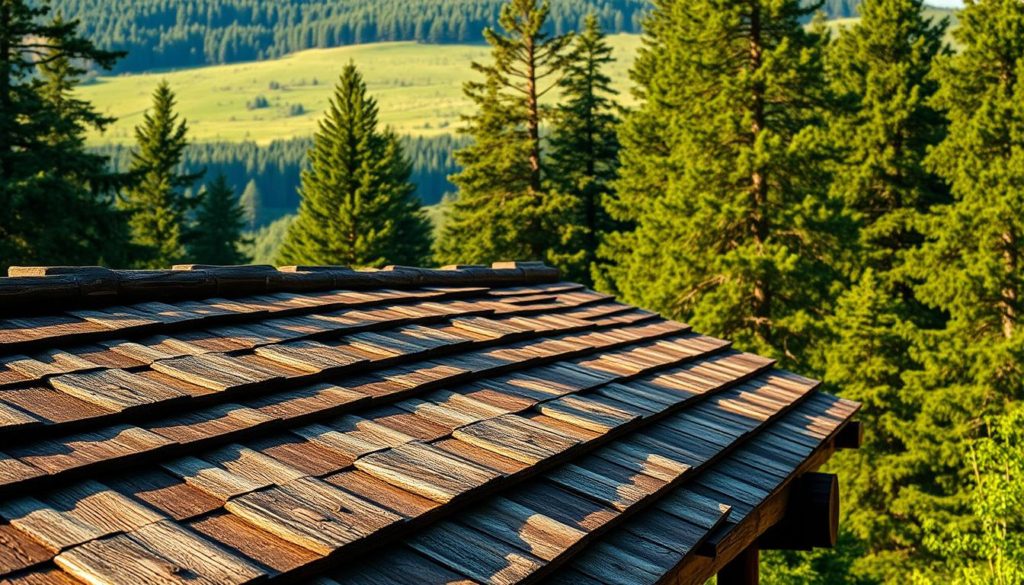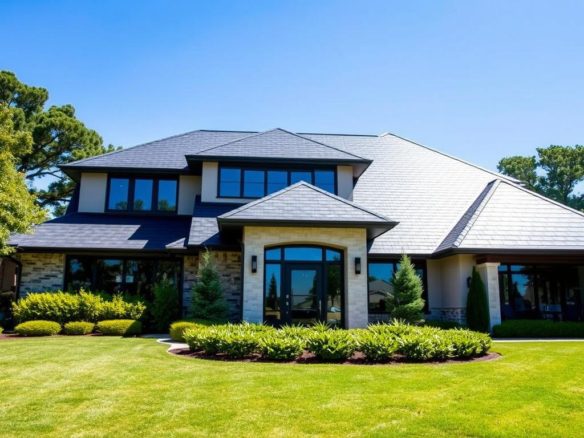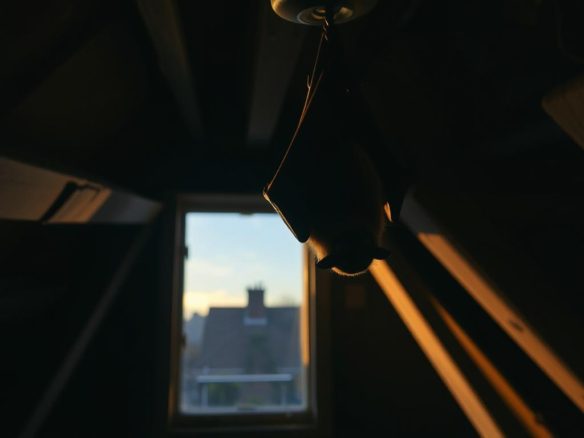A log cabin roof is key to a rustic retreat, blending function and beauty. It’s important to think about the design of a log cabin roof. A well-designed roof can make a cabin cozy and inviting, perfect for a rustic getaway.
Knowing what a log cabin roof looks like is essential for a perfect rustic retreat. Log cabins are gaining popularity, with eco-friendly materials and tiny cabins seeing a 25% increase in demand. Using reclaimed wood and natural finishes adds to their rustic charm, making them a favorite for sustainable homes.
Key Takeaways
- A well-designed log cabin roof can enhance the overall charm of the cabin and create a cozy atmosphere.
- Log cabin roof design is a key part of a rustic retreat, mixing function and beauty.
- Understanding what a log cabin roof looks like is vital for a perfect rustic retreat.
- Using reclaimed wood and natural finishes can boost the rustic appeal of log cabins.
- Log cabins are in high demand, with tiny cabins seeing a 25% increase in popularity over five years.
- Log cabin roof designs can vary, including gable, A-frame, and hip styles, each with its own charm.
- The cost of building a log cabin can range from $200 to $300 per square foot, depending on location and features.
The Classic Appeal of Log Cabin Roofs
Log cabin roofs have a unique charm that has been part of American architecture for centuries. Their traditional design has evolved, now including new materials and styles. The variety of log cabin roof types and styles adds to their appeal.
Homeowners can choose from different log cabin roof types, like metal, asphalt shingles, and wood shakes. Each style has its own benefits. For instance, metal roofs are durable and weather-resistant, while asphalt shingles are affordable and easy to install.
Log cabin roofs are great for blending with the environment and can even increase a property’s value. About 65% of log home owners value roof durability highly. The right roof color can also boost curb appeal, which can raise property value by up to 15% in competitive markets.
Here are some popular log cabin roof styles:
- Metal roofs: known for their durability and resistance to weathering
- Asphalt shingles: a popular choice due to their affordability and ease of installation
- Wood shakes: a traditional option that adds a touch of rustic charm to a log cabin
In conclusion, log cabin roofs are truly classic. With many types and styles to choose from, homeowners can find the perfect roof for their log cabin. This can also increase the cabin’s value.
What Does a Log Cabin Roof Look Like: Key Features
A log cabin roof has a steep slope to let snow slide off. It’s covered with log cabin roof materials like asphalt shingles, metal, or wood shakes. The roof’s pitch, slope, and material make it look good and work well.
Choosing a log cabin pitched roof design is important. The roof’s pitch affects its look and feel. A steeper pitch adds charm, while a shallower one gives more space inside. The roof material, from wood shakes to metal, also matters a lot.
- A steep pitch to allow snow to slide off easily
- A variety of log cabin roof materials to choose from, including asphalt shingles, metal roofing, and wood shakes
- A design that complements the overall aesthetic of the cabin, including the use of log cabin pitched roof designs
Homeowners can make a log cabin roof that looks great and works well. They can pick from many log cabin roof materials and designs to get the look they want.
Traditional Log Cabin Roof Shapes
The shape of a log cabin’s roof is key to its look and function. Traditional shapes include gable, A-frame, and hip roofs. Each has its own benefits and style.
The gable roof is a timeless choice, with its two sloping sides meeting at a ridge. It gives a classic look. The A-frame roof, with its steep pitch, adds a rustic charm. Hip roofs, with their four sides, offer a modern look and are sturdy against bad weather.
Popular Roof Designs
- Gable roofs: classic triangular shape with two sloping sides
- A-frame roofs: steeply pitched roof with a triangular shape
- Hip roofs: four sloping sides for added stability and protection
Choosing the right roof shape and materials is vital for a cozy cabin. The roof’s design and materials make the cabin both useful and lovely. When building a log cabin roof, consider the climate, local rules, and your taste. This ensures a roof that lasts a long time.
Essential Materials in Log Cabin Roofing
Choosing the right materials for a log cabin roof is key. Options like asphalt shingles, metal roofing, and wood shakes are popular. Each has its own benefits and drawbacks. For example, asphalt shingles are affordable and easy to put up, but they don’t last as long as others.
The weather in your area matters a lot. In sunny places, EPDM rubber roof coverings are great because they keep water out and handle UV rays well. But, shingle roofs might be better for places with more normal weather.
Here’s what you need to know about different roof materials:
- Asphalt shingles: affordable, easy to install, but may have a shorter lifespan
- Metal roofing: durable, resistant to weathering, but can be noisy during rainfall
- Wood shakes: natural, aesthetically pleasing, but require periodic maintenance
It’s important to check your roof often and fix any problems quickly. This helps your roof last longer, no matter what it’s made of. By picking the right materials and taking care of them, your roof will stay in good shape.

| Material | Warranty |
|---|---|
| Asphalt shingles | 15-30 years |
| Fiberglass shingles | 15-30 years |
| Metal roofing | at least 50 years |
Understanding Pitch and Slope Requirements
The pitch and slope of a log cabin roof are key. They help shed snow and rain and add to the cabin’s look. A steeper roof sheds snow better but costs more to build.
The International Residential Code (IRC) sets minimum roof slopes. For example, asphalt shingles need a 2:12 slope, while clay and concrete tiles need 2.5:12. Metal shingles require a 3:12 slope.
Regional Climate Considerations
Climate affects the roof’s pitch and slope. In snowy areas, a steeper roof is needed. In windy places, a gentler slope helps prevent damage.
Structural Requirements
The roof’s design must match the cabin’s structure. The pitch and slope must work with the walls and foundation.
Aesthetic Impact of Different Pitches
The roof’s pitch and slope greatly influence the cabin’s look. A steep roof adds drama, while a gentle one is more subtle. The choice depends on personal taste and cabin style.
| Roofing Material | Minimum Slope Requirement |
|---|---|
| Asphalt Shingles | 2:12 |
| Clay and Concrete Roof Tiles | 2.5:12 |
| Metal Roof Shingles | 3:12 |
Popular Log Cabin Roofing Materials
Choosing the right materials for a log cabin roof is key. They need to be strong, easy to care for, and handle different weather. Popular options include metal roofing, asphalt shingles, and wood shakes.
Each material has its own benefits. Metal roofing is strong and lasts a long time. Asphalt shingles are affordable and simple to put up. Wood shakes give a natural, rustic feel.
Here are some popular log cabin roof materials and their characteristics:
- Asphalt shingles: cost-effective, easy to install, and durable
- Metal roofing: robust, long-lasting, and low-maintenance
- Wood shakes: natural, rustic, and durable
- Cedar shakes: durable, resistant to rot and insect damage, and aesthetically pleasing
- Clay or ceramic tiles: sustainable, rustic, and durable, but heavy and expensive
In conclusion, picking the right roof materials for a log cabin depends on several things. These include your budget, what you like, and the weather. By thinking about these, you can choose materials that are strong, easy to care for, and look great.
| Material | Durability | Maintenance | Aesthetics |
|---|---|---|---|
| Asphalt shingles | 20-30 years | Easy | Classic, versatile |
| Metal roofing | 30-50 years | Low | Modern, sleek |
| Wood shakes | 30-50 years | Medium | Natural, rustic |
Structural Components and Support Systems
Log cabin roof construction relies heavily on structural components and support systems. These elements are key to the roof’s stability and durability. The roof’s shape and design must consider these components to create a strong foundation for the cabin.
The ridge beam, rafters, and load-bearing walls are vital for a log cabin roof. The ridge beam is essential, supporting the roof’s weight. In homes with gable dormers, a log ridge beam is used for each dormer, showing a custom design.
Ridge Beam Construction
The ridge beam’s construction is critical. It must support the roof’s weight and provide a solid base for the cabin. Log purlins, used in pairs, help distribute the roof’s weight evenly.
Rafter Arrangements
Rafter arrangements are also important. They must support the roof’s weight and provide a solid foundation. Log rafters run from the ridge beam to the log walls, made from square timbers or round logs.
The jerkinhead roof is a common shape for log cabins. It has a gable with the peak clipped, making it stable and wind-resistant. This design is great for areas with strong winds or extreme weather.
Load-Bearing Considerations
Load-bearing considerations are critical in log cabin roof construction. The roof’s weight and any extra features like skylights or decorative beams must be considered. This ensures the roof can support the weight and provide a solid foundation for the cabin.
Design Elements That Define Character
Log cabin roof styles are key in defining a cabin’s character. They’re not just about looks; they make the cabin feel warm and welcoming. Log cabin barndominiums, for example, bring the cozy feel of traditional cabins into modern homes.
The style, shape, and materials of a log cabin roof all add to its unique charm. Gable roofs are popular for their ability to offer more upstairs space and architectural flair. On the other hand, gambrel roofs are favored in New England for their snow-handling skills.
Some top log cabin roof styles include:
- Gable roofs
- Gambrel roofs
- Hip roofs
These styles can be paired with materials like asphalt shingles, metal, or cedar shakes. The choice depends on the look you want, your budget, and the local climate.
In summary, the design of a log cabin roof shapes its character and beauty. By picking the right design, homeowners can make their cabin a cozy retreat that matches their style and the natural setting.
Weather Protection and Insulation Features
Log cabin roof materials are key to keeping the cabin cozy and energy-efficient. Good insulation is vital for a warm interior, no matter the season. The roof must have moisture control, temperature management, and ventilation to protect against weather damage.
Important features include Bison Board® and foam insulation to fight thermal breaks and ice dams. The thermal blanket system cuts down on heating and cooling costs. Western Red Cedar Fascia and expanded polystyrene roof panels also boost the roof’s strength and warmth.
Good insulation keeps the cabin warm all year. Inter-beam insulation cuts down on heat loss and looks good. Floor insulation keeps the cabin dry and strong. Proper insulation makes the cabin cozy, energy-efficient, and eco-friendly.
- Less energy use and higher property value
- Better comfort and air quality inside
- Longer-lasting and more durable structure
- Stronger against weather and disasters
Choosing the right roof materials and methods makes a cabin comfortable and green. It meets and goes beyond what homeowners want.
Maintenance Requirements for Log Cabin Roofs
Keeping a log cabin roof in good shape is key to its longevity. This means regular checks, log cabin roof repair, and replacing worn-out parts. Look out for cracks, doors and windows that don’t shut right, and any structural shifts.
Weather can also harm your roof, causing discoloration, soft spots, and peeling finishes. Signs of pests include holes, sawdust, and live bugs. Cleaning, applying coatings, sealing gaps, and pest checks are all part of the routine.
Some important tasks for log cabin roof care include:
- Cleaning logs and applying protective coatings
- Sealing cracks and checking for pest damage
- Inspecting for weather-related damage and addressing issues promptly
By focusing on log cabin roof maintenance and fixing problems fast, you can avoid big repairs. Regular checks and fixes can also save you money in the long run.
| Maintenance Task | Frequency | Importance |
|---|---|---|
| Cleaning logs | Annually | High |
| Applying protective coatings | Every 5 years | Medium |
| Inspecting for pest damage | Quarterly | High |
Conclusion: Creating Your Perfect Log Cabin Roof
Designing the perfect log cabin roof is all about finding the right mix of function and beauty. We’ve seen how the roof’s style, materials, and how it’s built can change your cabin’s look and how well it works. Each roof type, from classic gable to modern butterfly, has its own special benefits.
Think about your local weather, what your cabin needs structurally, and what you like. Gable roofs are great for keeping snow and rain off, while hip roofs are stable and offer more room. Metal roofs last a long time, and wood shingles or shakes add warmth and a natural look. Knowing about log cabin roofs helps you make a choice that looks good and works well.
When building your log cabin, don’t forget to take care of your roof and use top-notch materials. This way, your roof will be a beautiful part of your cabin, showing off its charm and lasting beauty.
FAQ
What does a log cabin roof look like?
A log cabin roof has a steep slope to let snow slide off. It’s covered with materials like asphalt shingles, metal, or wood shakes.
What are the key features of a log cabin roof?
Key features include the roof’s pitch, slope, and material. These elements make the roof look good and work well.
What are the traditional log cabin roof shapes?
Traditional shapes are gable, A-frame, and hip roofs. Each shape has its own look and benefits, making different styles possible.
What are the popular log cabin roofing materials?
Popular materials are asphalt shingles, metal, and wood shakes. Each has its own pros and cons.
What are the structural components and support systems of a log cabin roof?
The roof’s structure includes the ridge beam, rafters, and load-bearing walls. They support the roof’s weight and provide a strong base for the cabin.
What design elements define the character of a log cabin roof?
Design elements like style, shape, and materials make a log cabin roof unique. They give the cabin its special look and feel.
What are the weather protection and insulation features of a log cabin roof?
The roof protects against weather and keeps the cabin warm or cool. It has systems for moisture control, temperature, and ventilation. These are key for comfort and energy savings.
What are the maintenance requirements for a log cabin roof?
Keeping the roof in good shape is vital. This includes regular checks, repairs, and replacing materials to ensure it lasts long.







Join The Discussion